| |
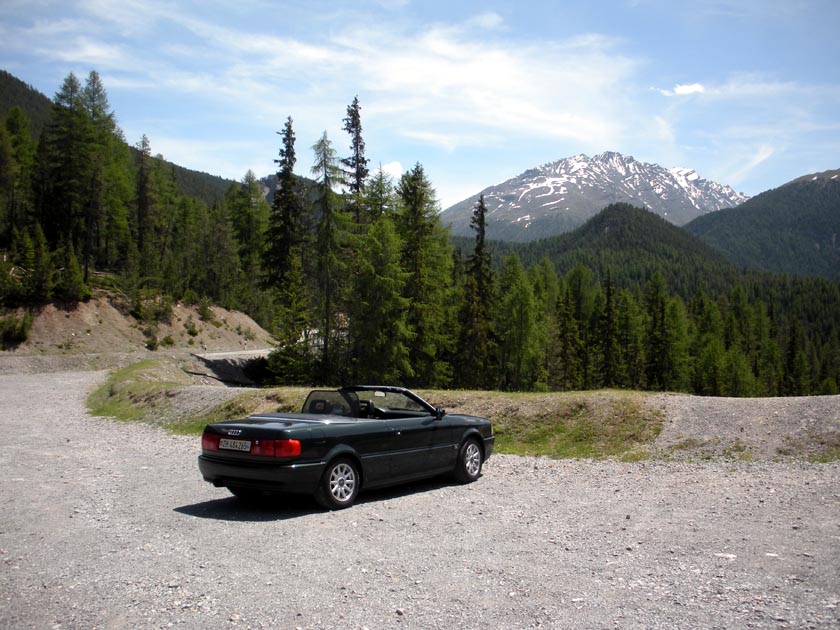 |
| Thursday
-- 2:01 p.m. |
| This
gravel area provided our first chance to stop and look around. It
is located just beyond |
| the
village of Susch, within the Swiss National Park. My car is
pointing in the direction we |
| will
travel. Leaving the park, we will continue to the summit of the
Ofen Pass. From that point, |
| it
will be downhill for the rest of the day, through the town of Müstair
and into Italy. Once inside |
| Italy,
we will travel Highways 41 and 38, en route to Merano where we will
spend the night. |
| |
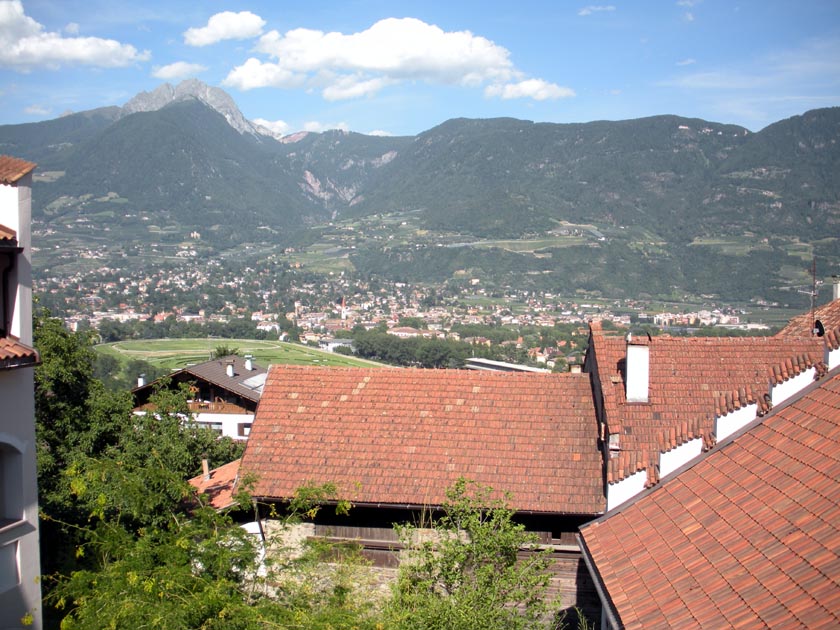 |
| Thursday
-- 5:01 p.m. |
| This
was the view from my hotel balcony, as we settled in for the night.
We were now on the |
| Mediterranean
side of the Alps where the temperature on this day hovered near 100;
hence |
| the
slight haze in the distance. We stayed in the town of Marling,
just outside of Merano. The |
| Etch
River runs between Merano and Bolzano, creating the Etch Valley, a
fertile basin filled |
| with
fruit orchards in the flatlands and vineyards along the hillsides. |
| |
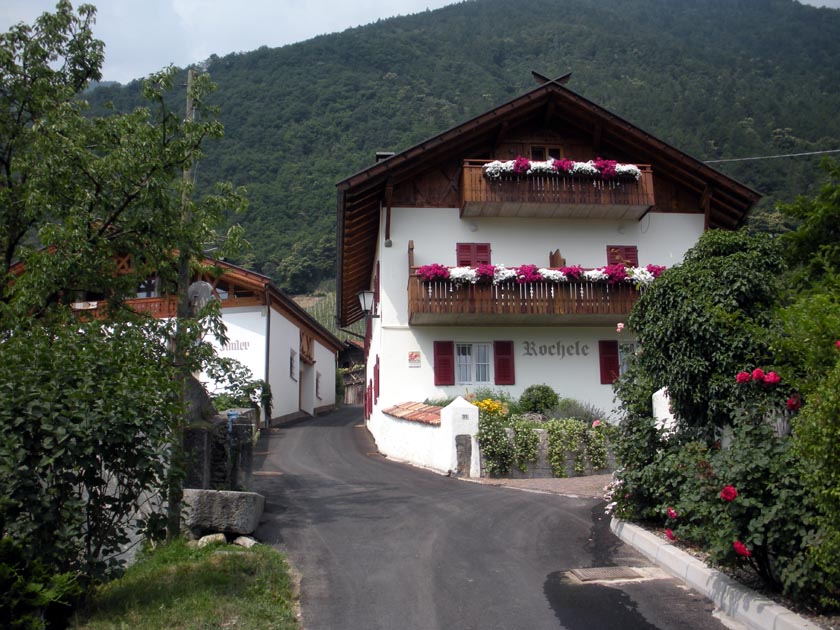 |
| Friday
-- 10:47 a.m. |
| The
trip passed at a leisure pace. Given the terrain, we averaged 100
miles per day, rising |
| at
around 8:00 a.m. each morning and, after breakfast at the hotel, hitting
the road around |
| 10:30
or so and checking into our next hotel by approximately 3:00 p.m.
The photo above |
| was
taken from the entrance of the Hotel Oberwirt where we spent our first
night. I had a |
| few
minutes to spare after breakfast on Friday morning (waiting on Reinhard)
and took a |
| short
walk up the hill. A small section of vineyard is visible between
the two buildings. |
| |
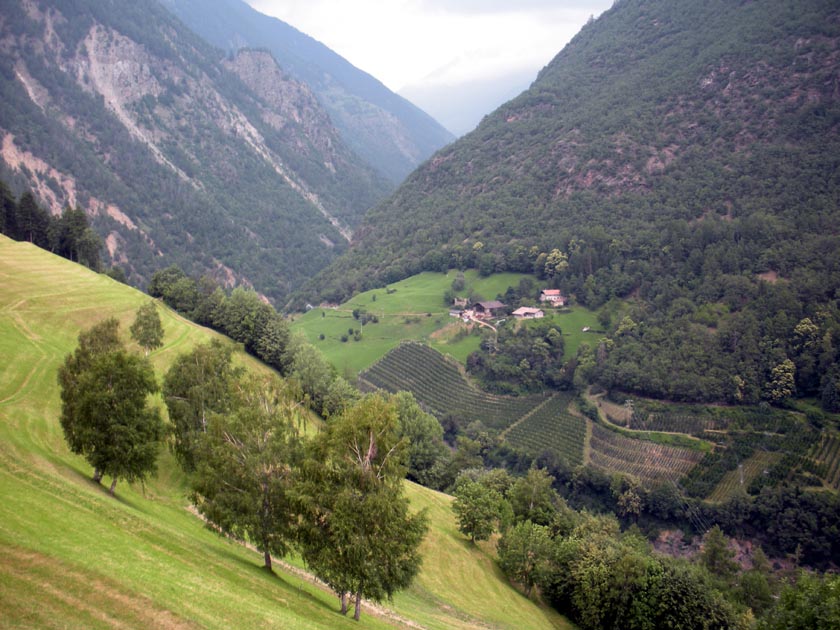 |
| Friday
-- 1:05 p.m. |
| One
of the "must see's" on Reinhard's list was the Reinhold
Messner Mountain Museum, |
| located
in Castle Juval. Messner is a legend among mountain climbers,
having scaled the |
| highest
peak on every continent. We were required to park our car at the
foot of the hill |
| and
ride a small bus almost to the top. When the bus could no longer
navigate the narrow |
| road,
we disembarked and walked the last kilometer up to the castle. I
took this shot from |
| the
roadway, looking down, fascinated by the small secluded winery hidden in
the valley. |
| |
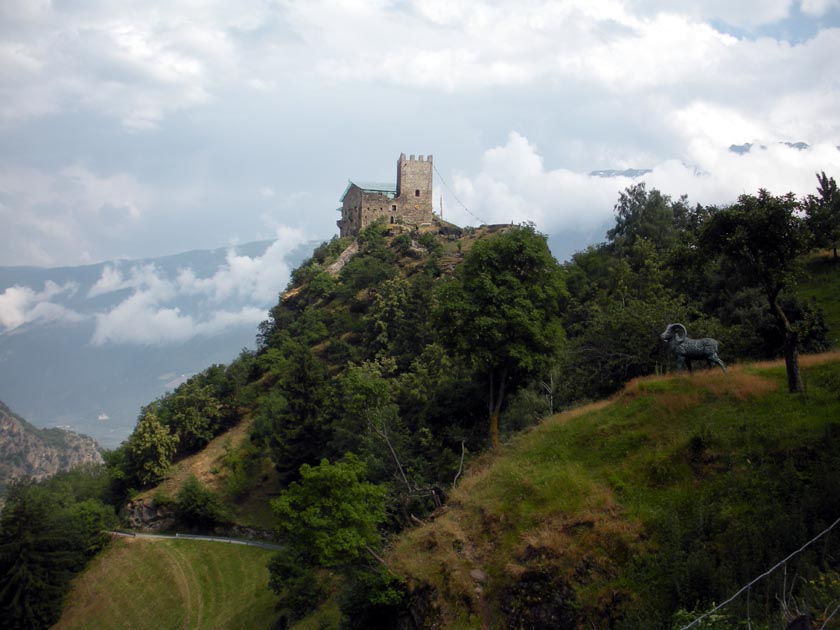 |
| Friday
-- 1:22 p.m. |
| Approaching
Castle Juval on foot. The elk-like animal on the right is made of
cast iron. |
| The
road we will walk back down to the bus meeting point is visible in the
lower left. |
| |
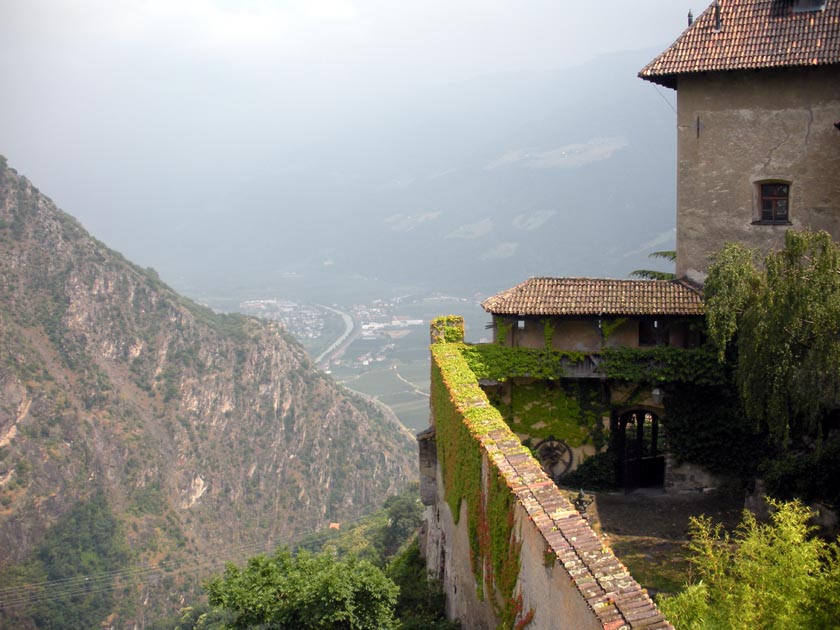 |
| Friday
-- 2:49 p.m. |
| Again,
Friday was extremely warm, so this photo suffers in the distance.
This shot was taken |
| from
Castle Juval, looking down the valley floor whence we came. A
"must" on Reinhard's list, |
| it
turned out to be a bust, because the so-called museum offered nothing at
all from Messner's |
| mountain
climbing adventures; instead, we were given a tour of an eclectic
collection of Tibetan |
| art
work strewn about the castle: hokey and over-priced. All was not
lost, however, as we were |
| treated
to hair-raising rides up and down the mountainside by a young Italian man
at the wheel |
| of
a twenty-passenger bus who had obviously driven the stretch many times,
casually screeching |
| around
sharp, precarious turns with mere millimeters separating the bus from
sheer granite walls. |
| |
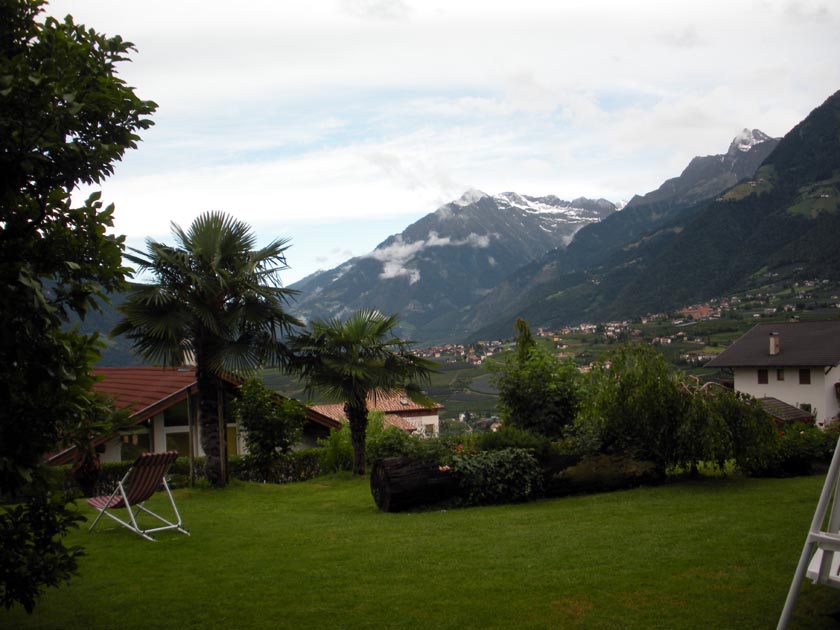 |
| Saturday
-- 8:16 a.m. |
| On
Friday evening, we found rooms at a small Hotel-Garni (the three-star
Hotel Katnau) in the |
| town
of Schenna -- and were pleasantly surprised at a price of only 41 Euros
for a single room |
| with
breakfast. (A hotel-garni is a small establishment offering a
breakfast meal only with no |
| restaurant
services.) This photo was taken from our breakfast table on
Saturday morning. |
| |
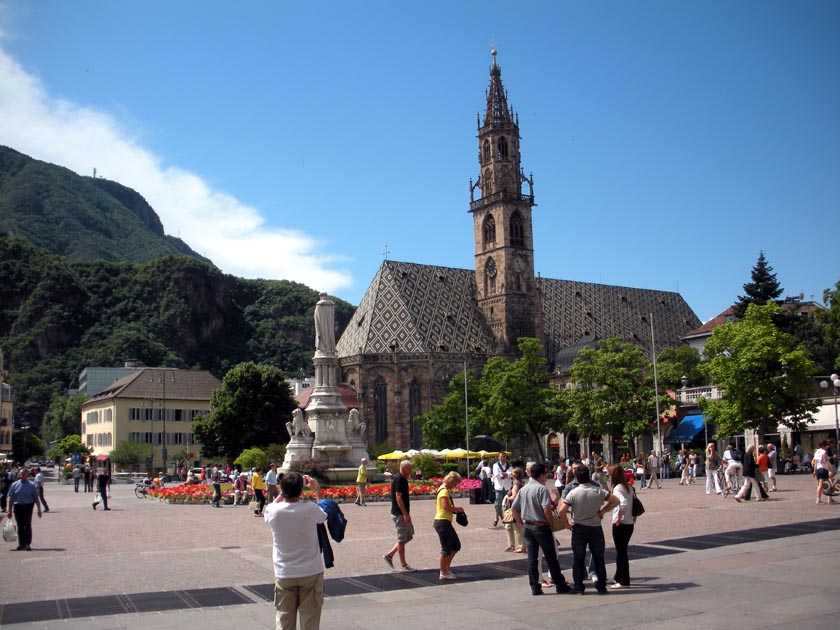 |
| Saturday
-- 11:23 a.m. |
| From
Schenna, we drove to Bolzano and spent the morning wandering the narrow
cobblestone |
| streets
among small shops and stalls in the old town. Bolzano is
historically rich and beautiful, |
| but
beauty can be difficult to find on a Saturday morning, as local
residents on weekly shopping |
| errands
stream into town, joining with tourists in a crush of humanity.
Reinhard bought a bag of |
| fresh
fruit, and we stopped at a sidewalk cafe for a cup of coffee before
hitting the road again. |
| |
 |
| Saturday
-- 1:06 p.m. |
| Leaving
Bolzano, we entered the Dolomiti Highway, a narrow two-lane road winding
up into |
| the
Dolomites, a section of the Alps. For those who relish the growl
of a high revving engine, |
| five-speed
transmission, and the soft feel of calfskin driving gloves, this is
where the tour really |
| begins.
Accelerating into the mountains, we stopped first at the Karersee (Lake
Karer) which |
| lies
at 1530 meters elevation. The Latemar Range (2864 meters) lies
opposite, but on this day |
| they
are shrouded in low-lying clouds (photo above). The lake is
crystal clear with a cinder path |
| trail
hugging the shoreline. We grabbed the opportunity for a little
exercise and circled the lake. |
| |
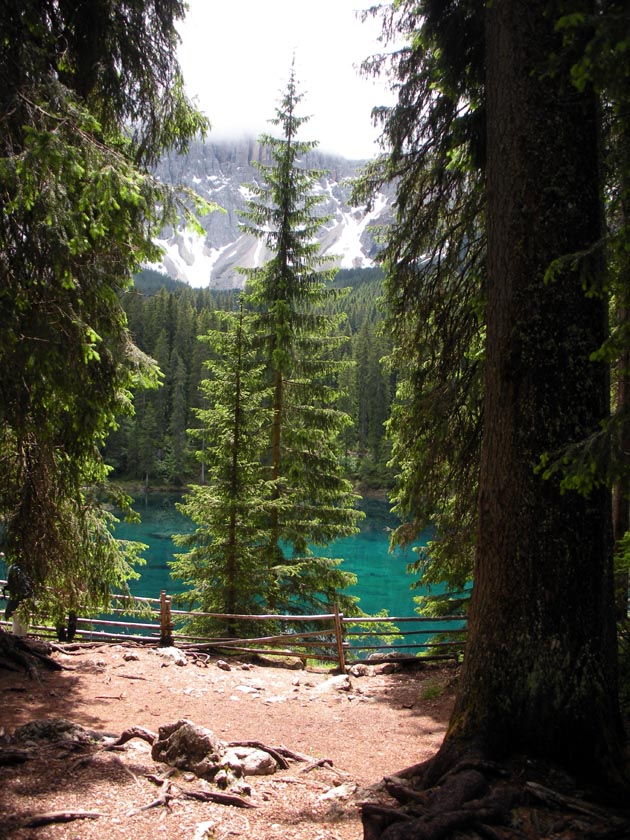 |
| Saturday
-- 1:31 p.m. |
| After
walking around the lake, we headed back to the car. As I turned to |
| leave
the lake, the sun broke through, and I snapped this shot.
Hopefully, |
| it
conveys some idea of just exactly how clear the water appeared.
Were |
| I
an angler, I would consider this lake unsporting, as large trout
abounded, |
| swimming
lazily in the shallows, easily spotted from ten or twenty meters |
| away.
A simple flick of the wrist, and you could drop your fly right in the |
| fish's
path. No anglers appeared that day; hopefully, they are not
allowed. |
| |
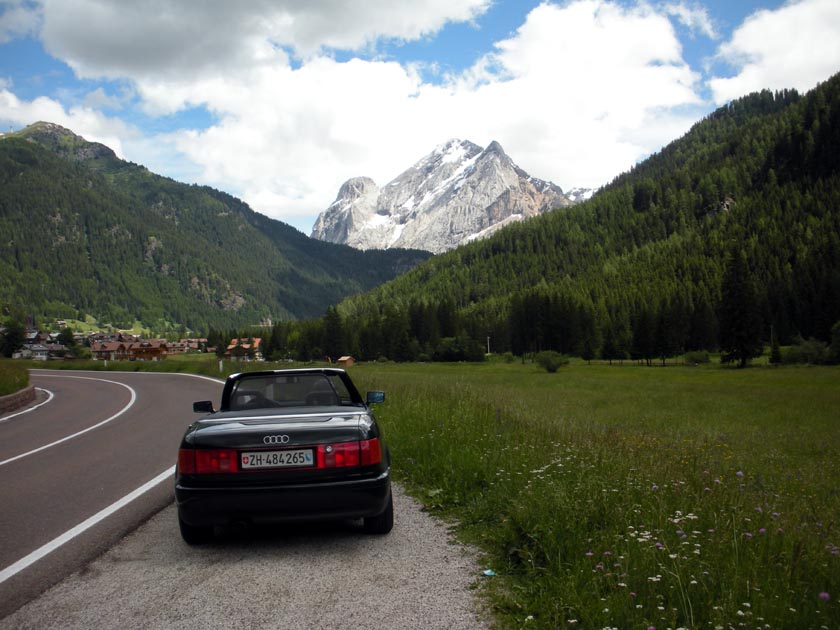 |
| Saturday
-- 2:45 p.m. |
| We
stopped often to enjoy the scenery. Small gravel turn-outs like
this one appeared every |
| couple
hundred meters, so
whenever a particularly inviting vista presented itself, such as here, |
| we
were able to pull over within a reasonable distance, exit the car, and
capture it on film. |
|
| On
an unpleasant note, the weekend brought out the motorcycle crowd, mostly
from Germany |
| but
also many driving up from the larger cities of southern Italy.
These people, released from |
| the
pressure of a weekly work grind, attacked the mountains en mass and with
unusual gusto, |
| almost
completely disregarding others on the road. To be fair, some were
quite polite; but most |
| treated the road as their personal race course, clad in
black leather head
to foot and sporting |
| futuristic
helmets with shiny chrome face shields, leaning around blind corners at
top speed and |
| roaring
off at full throttle. Several times, on-coming bikers rounded a
bend and drifted into my |
| lane,
on a collision course, before glancing up and seeing me and correcting
back onto their own |
| side
of the road. Reckless driving wasn't the only problem.
Apparently, it is common practice to |
| remove
the baffles from motorcycle mufflers, so when a rider approaches
from behind and roars |
| on
past, the increased decibel levels cause significant discomfort to any
gentlemanly convertible |
| driver
tooling along with the top down at vacation speed. From that point
on, if I saw even one |
| motorcyclist
in my rear-view mirror, I pulled over into the next cut-out and allowed
him to pass. |
| |
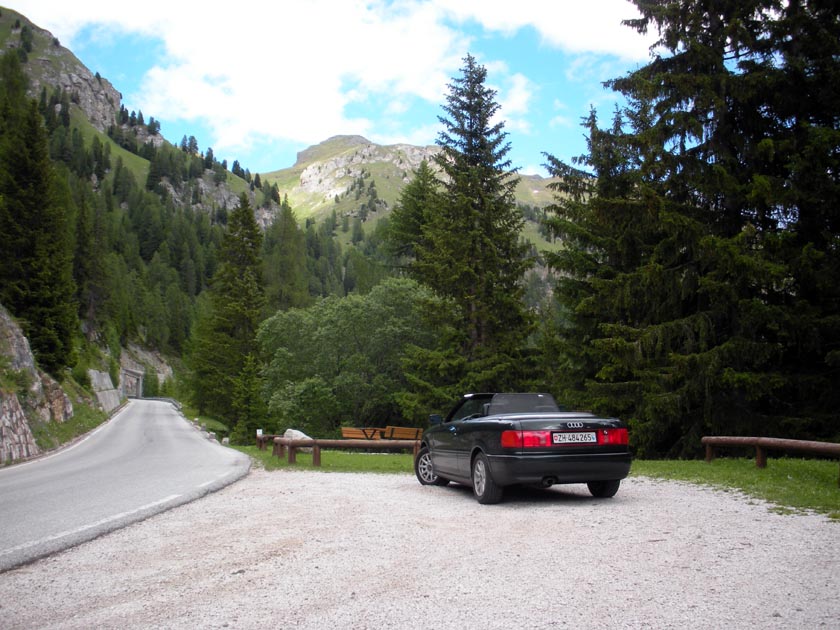 |
| Saturday
-- 3:07 p.m. |
| Another
scenic turnout, this one necessitated by an urgent call from Nature. |
| (A
German-speaking man might call this a "pink-el pow-zah.") |
| |
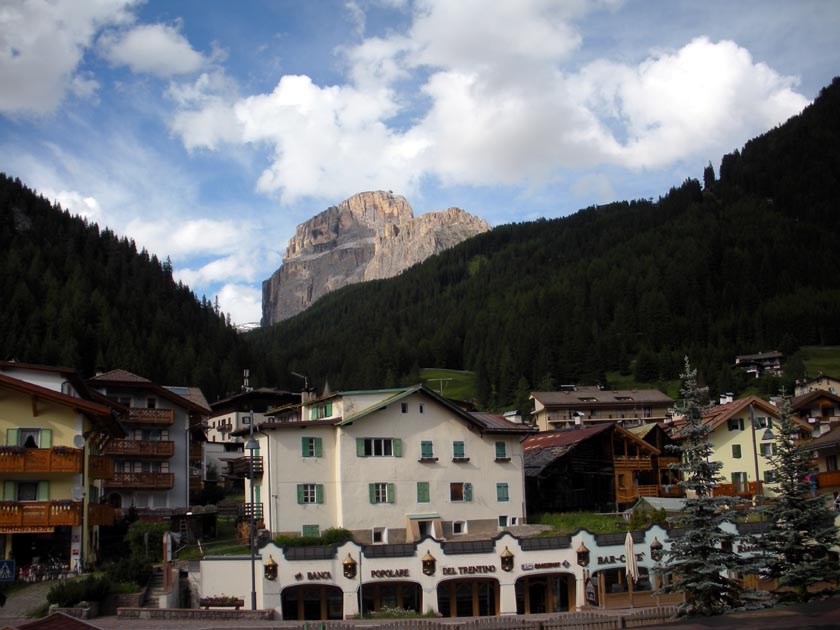 |
| Saturday
-- 5:36 p.m. |
| This
was the view from my balcony at the Hotel La Perla in Canazei. We
got settled in a little |
| later
than usual that day, having made a wrong turn and driven all the way up
to Passo Fedaia |
| (Fedaia
Pass, 2,057 meters), then turning around and back-tracking forty minutes
to Canazei |
| where
we had turned right instead of left. The road to Passo Fedaia
looked just fine to me, but |
| it
wasn't on Reinhard's original itinerary, and he insisted on staying true
to history by traversing |
| Passo
Pordoi (2,239 meters), which we would now attempt the next morning.
In the meantime, |
| I
treated myself to a double-schnitzle dinner with a large salad and
heaping plate of "pommes |
| frites"
(french fries) washed down with a nearly half-liter glass of spätzi (a
cold drink containing |
| a
mixture of Coca Cola and carbonated lemonade). A good meal can
solve just about any crisis. |
| |
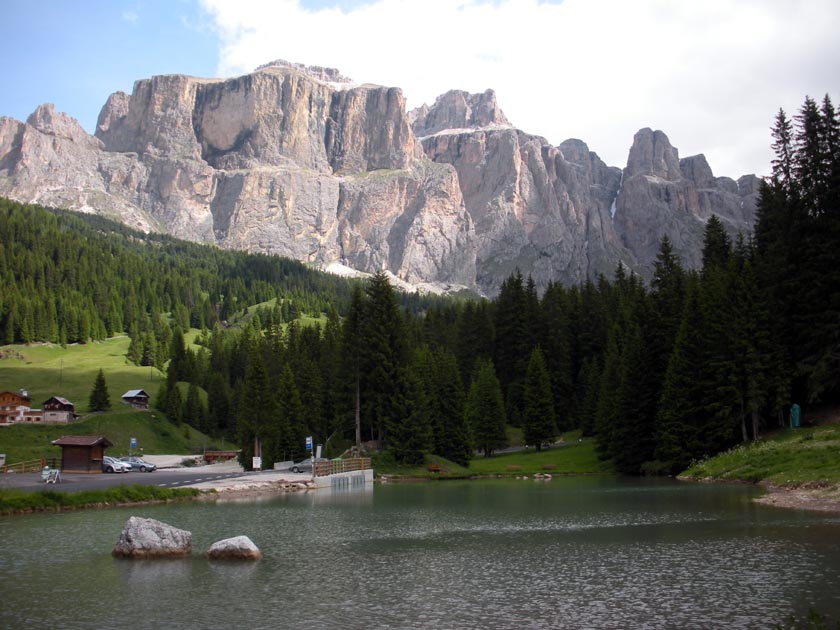 |
| Sunday
-- 10:18 a.m. |
| Having
departed the town of Canazei (and having turned left this time), we are
headed toward |
| Passo
Pordoi and the town of Cortina. The range of mountains in the
background is called |
| Sellagruppe
in German and Gruppo Del Sella in Italian (3152 meters). |
| |
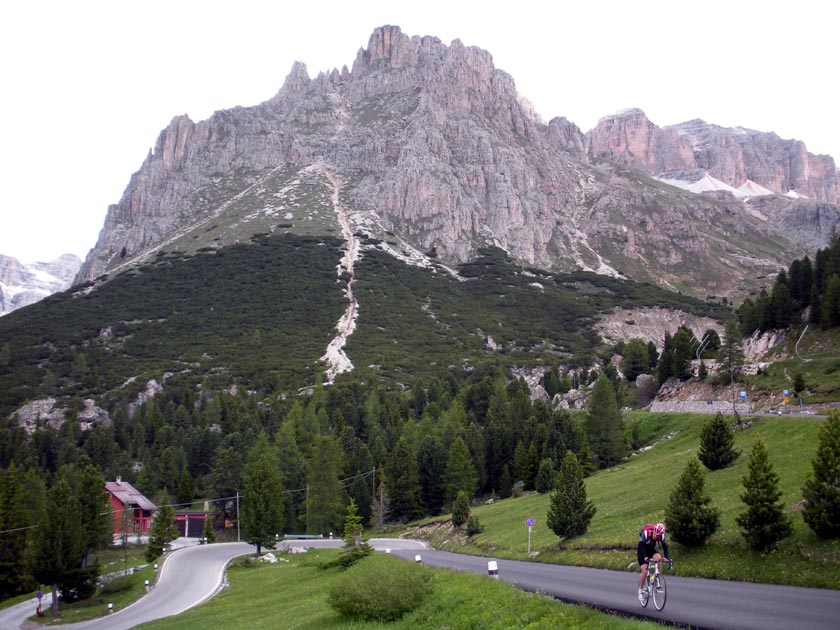 |
| Sunday
-- 10:44 a.m. |
| This
scene is very representative of serpentine roads in the area. In
addition to motorcyclists, |
| we
also shared the pavement with a hardy breed of bicyclists. The
extreme stamina and mental |
| discipline
required to scale these peaks on two wheels defies description, and
these men and |
| women
have my deepest respect. I gave each of them a wide berth and a
friendly wave. |
| |
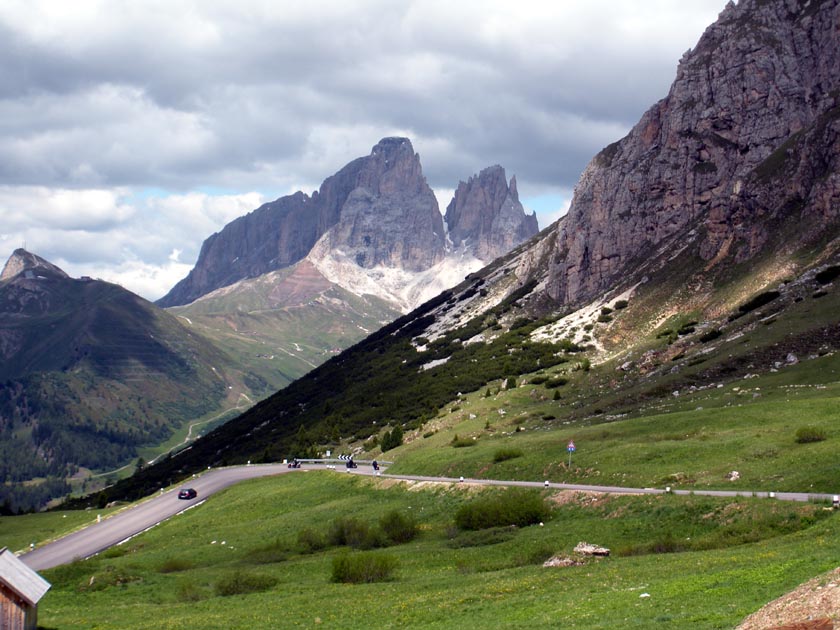 |
| Sunday
-- 10:55 a.m. |
| The
landscape varied from one bend in the road to the next and from one
minute to the next. |
| |
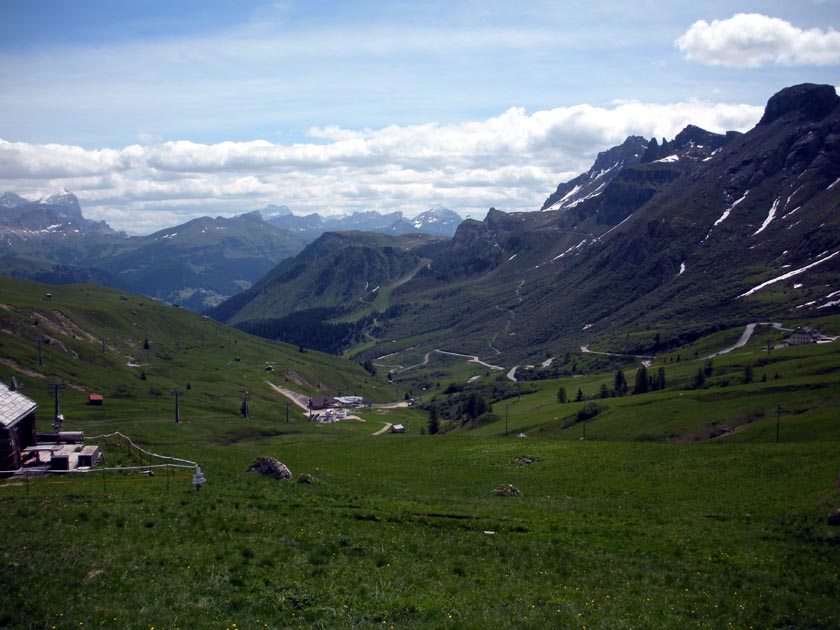 |
| Sunday
-- 11:15 a.m. |
| Having
cleared Passo Pordoi summit, we are preparing to descend the other side,
following |
| the
narrow ribbon of road down the middle of the valley on to the next ridge
of mountains in the |
| distance.
The white streaks on the hillsides to the right are snow remnants.
(It's late June!) |
| |
 |
| Sunday
-- 11:24 a.m. |
| Slightly
farther down the same valley as in previous photo. Town of
Cortina lies ahead. |
| |
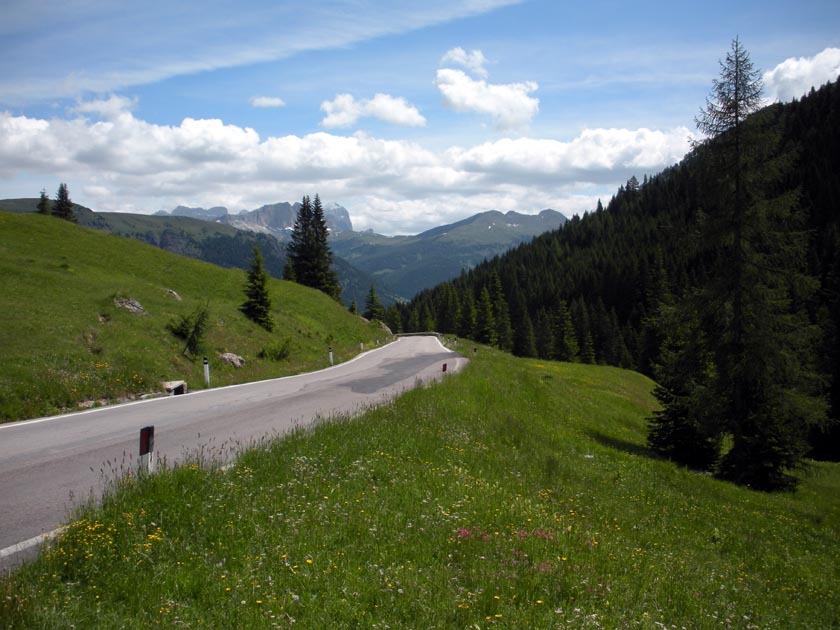 |
| Sunday
-- 11:31 a.m. |
| A
gorgeous stretch of wide open road. Note the wild flowers in
foreground -- typical of the area. |
| |
 |
| Sunday
-- 12:50 p.m. |
| In
the town of Cortina, we stopped at a small outdoor cafe for a sandwich
and a cup |
| of
coffee, surrounded by a thousand motorcyclists. (Well, it seemed
like that many.) |
| |
 |
| Sunday
-- 1:14 p.m. |
| Stopped
at another roadside cut-out, we were attracted by the velvety texture |
| of
the grassy hillside opposite -- and the haphazard arrangement of the
buildings. |
| |
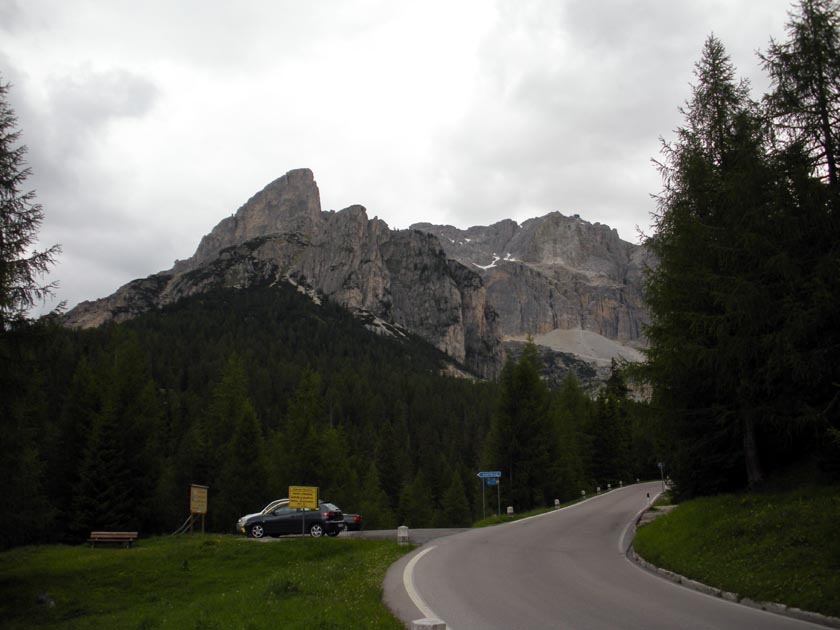 |
| Sunday
-- 1:48 p.m. |
| With
the passing days, the weather turned cooler, and driving with the top
down became an |
| issue.
At higher elevations, the winds increased, and the temperature dropped.
Reinhard, at |
| his
age, caught cold easily, so he asked me now and then to close the
windows and raise the |
| top.
Invariably, after acceding to his wishes, another convertible soon drove
by in the opposite |
| direction,
cockpit open to the skies, and we got "The Glare." I
slumped in my seat and cringed, |
| with
a pretty good guess as to what that other driver must have been thinking:
Why on earth do |
| you
own a convertible, if you choose to drive it in this paradise with the
top up? It's an unwritten |
| rule
of the road; if you own a convertible, you must drive it with the top
down, baring rain or snow. |
| Rolling
the windows up in order to cut down on wind noise is permissible, but
the top stays down. |
| Whenever
possible from that point onward, we dropped the top and bundled up
against the cold, |
| me
in my baseball cap and Gortex jacket; Reinhard sporting a stylish parka,
floppy hat and scarf. |
| |
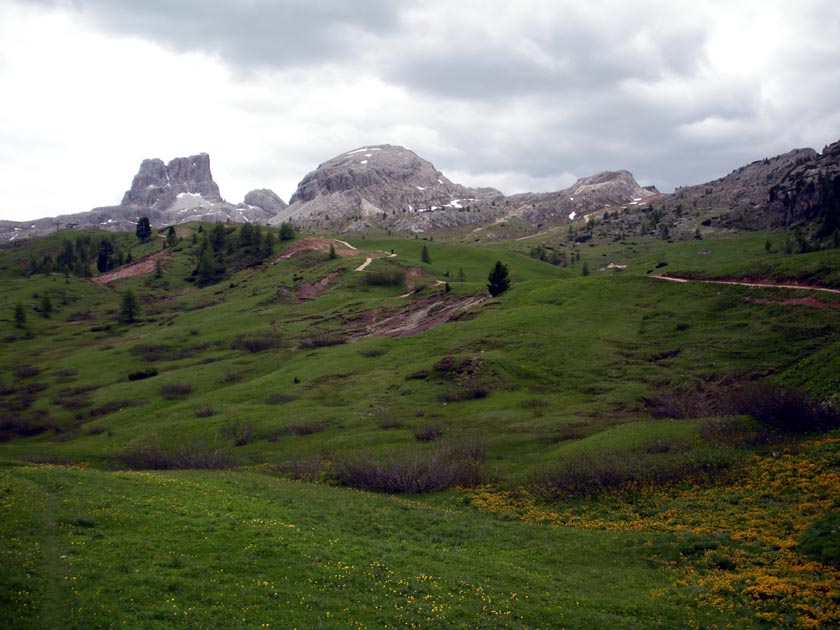 |
| Sunday
-- 1:53 p.m. |
| Five
minutes have passed since the last photo, and look at the change
in scenery. Amazing! |
| |
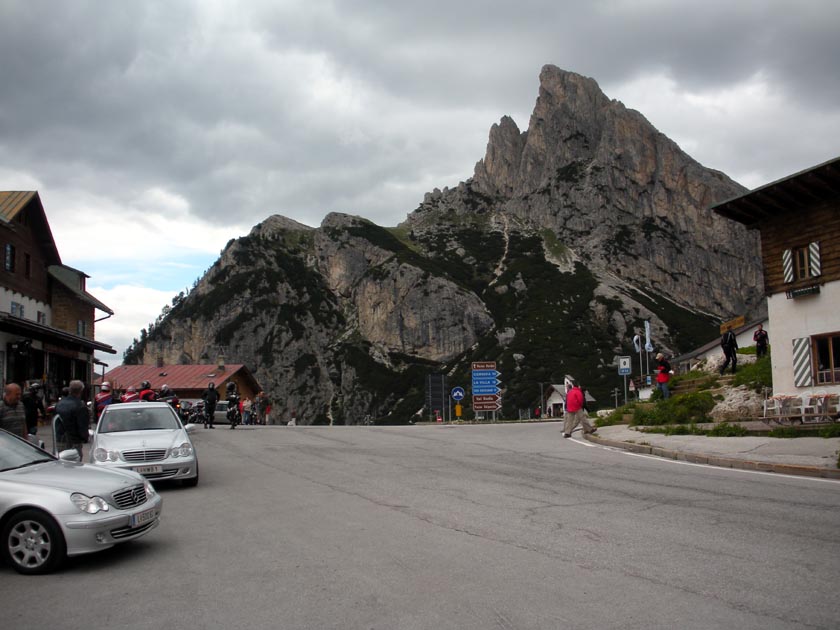 |
Sunday
-- 1:55 p.m.
|
| We
have reached the summit of Passo Falzarego (2145 meters). |
|
Leaving this point, we will drive away to the right, in the direction of
the arrows on the signpost. |
| |
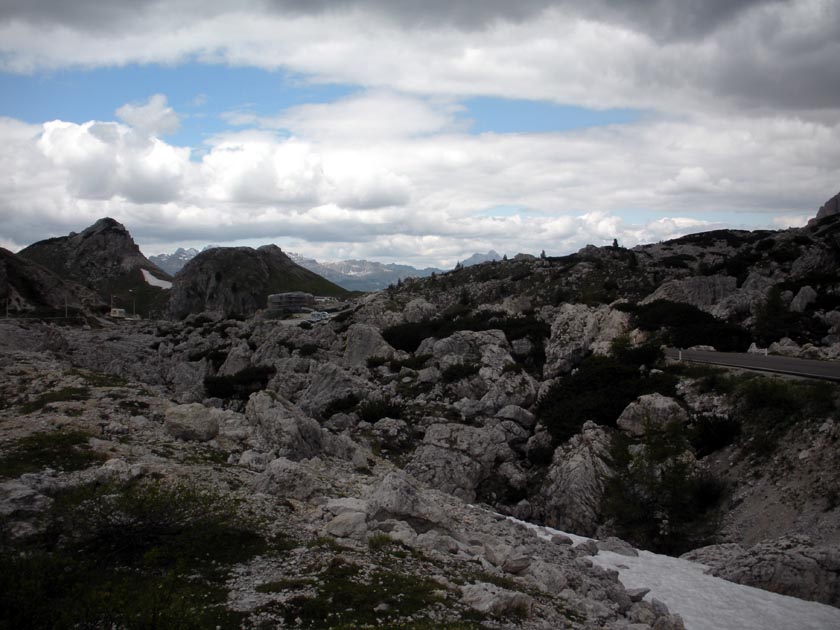 |
| Sunday
-- 1:57 p.m. |
| Leaving
Passo Falzarego, preparing to descend into the valley, toward San
Cassiano where we |
| will
spend the night. See the road at the middle right? The white
patch at lower right is snow. |
| |
 |
| Sunday
-- 2:59 p.m. |
| This
view awaited at the window of my room in the Hotel Armentarola in
Cassiano. Obviously, |
| Reinhard
no longer possessed the hand-eye coordination, reaction time, depth-perception,
or |
| any
other physical attribute that would have allowed him to share any
driving time on the steep |
| narrow
roads of the Dolomites, so yours truly had been forced to do it all, and
the strain began |
| to
mount. To my extreme delight, this hotel room had a full-size
Jacuzzi whirlpool bathtub, and |
| I
wallowed in that baby for an hour, water jets turned up to full blast,
bubbles everywhere. Ah! |
| |
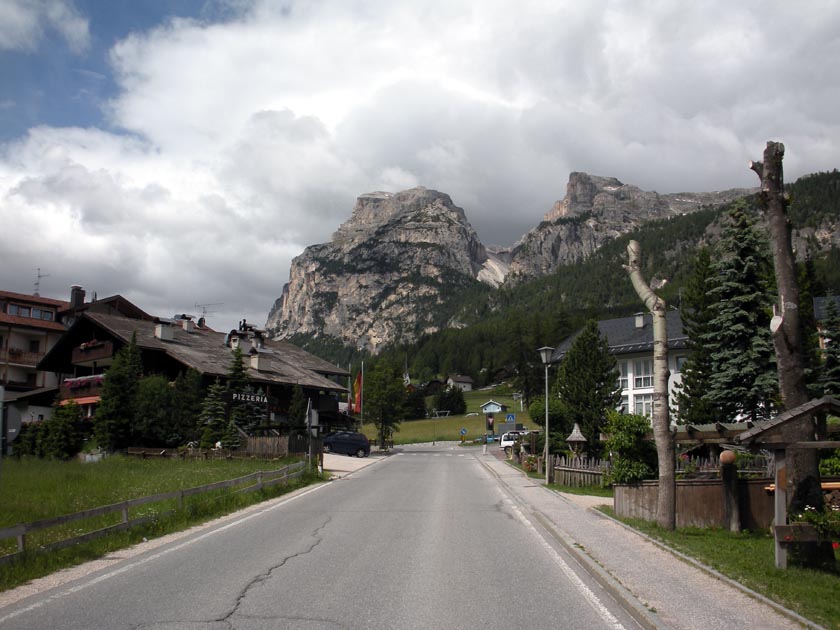 |
| Monday
-- 10:29 a.m. |
| Having
left our hotel in Cassiano, we drove a few kilometers and entered the
town of La Villa. |
| |
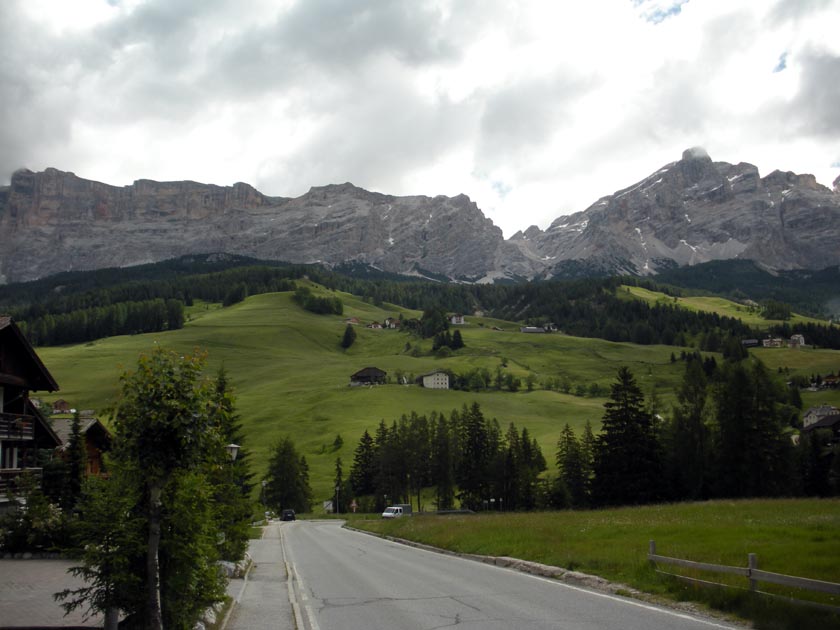 |
| Monday
-- 10:30 a.m. |
| A
minute later, I turned 180 degrees and snapped this photo of
the terrain we had just |
| traveled.
The road bends to the right and skirts around the mountains in the
background. |
| |
 |
| Monday
-- 10:51 a.m. |
| This
is the town of Corvara (1558 meters). We stopped to replenish our
water supply and |
| walked
from one end of town to the other looking for a market. In every
small town we had |
| visited
thus far, stores were closed from noon until 4:00 p.m., so we felt lucky
to have arrived |
| earlier
on this day. The impressive peak in background is the Sassongher
(2,665 meters). |
| |
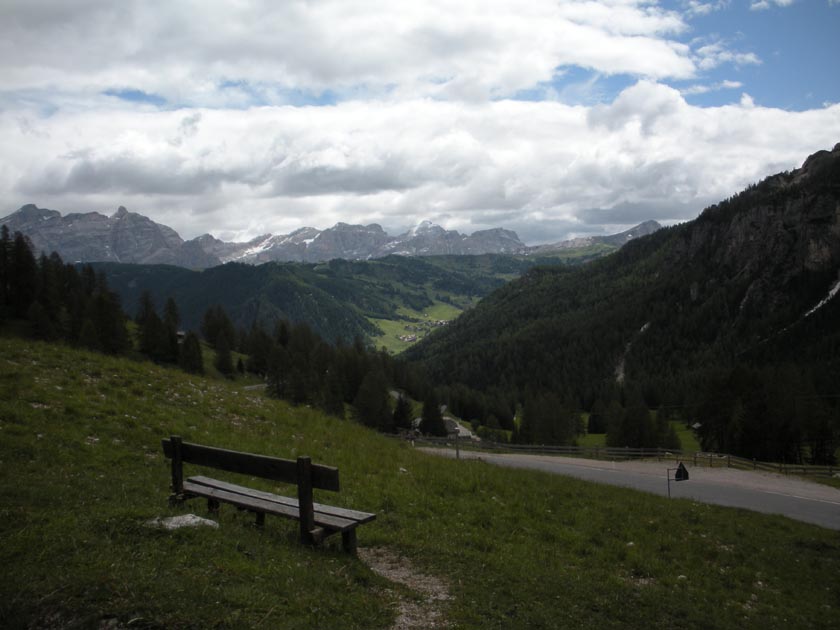 |
| Monday
-- 11:31 a.m. |
| Looking
back toward Corvara, climbing again, this time en route to the town of
Arabba-Reba. |
| It's
a good long hike from anywhere to reach this bench; but the view is
certainly worth it. |
| |
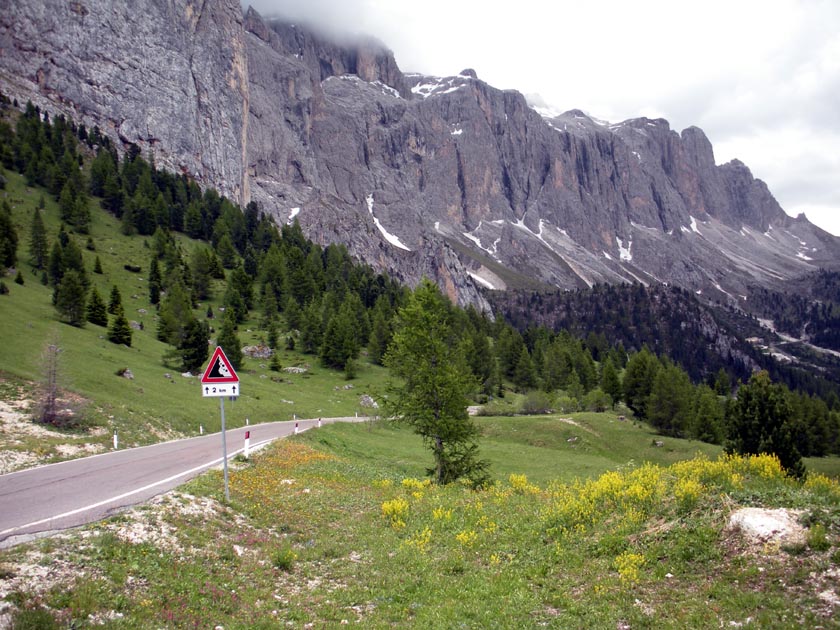 |
| Monday
-- 11:57 a.m. |
| We
spent quite a while at this spot. It actually hailed for a few
minutes when we first arrived, |
| then
winds blew that away, and we waited for the clouds to move, so we could
photograph |
| the
peaks opposite, called Rosengartengruppe (German) or Gruppo del
Catinaccio (Italian). |
| |
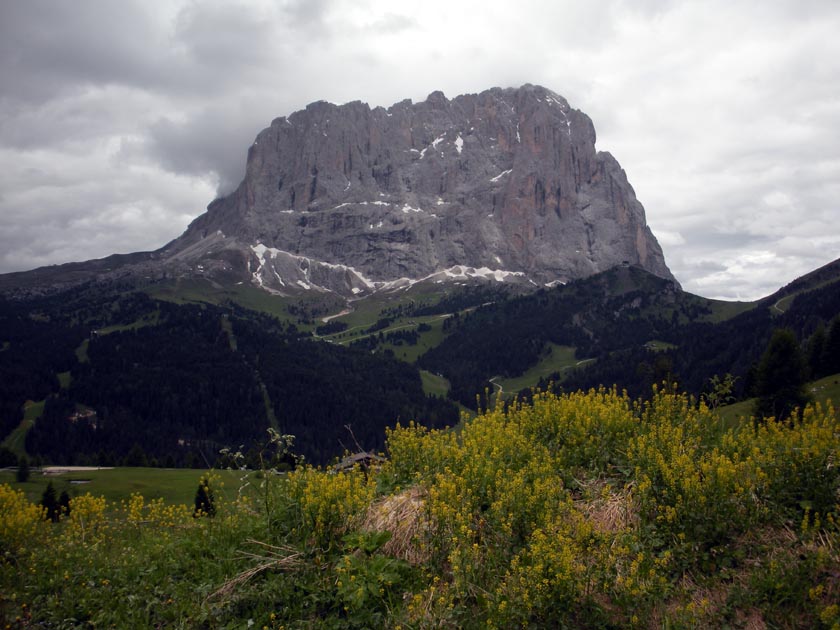 |
| Monday
-- 12:01 p.m. |
| Standing
in the same spot as previous photo, I swung my lens to the right and
took this shot. |
| The
road curves right and runs along the juncture of grass and dark trees
rising up the hill. |
| |
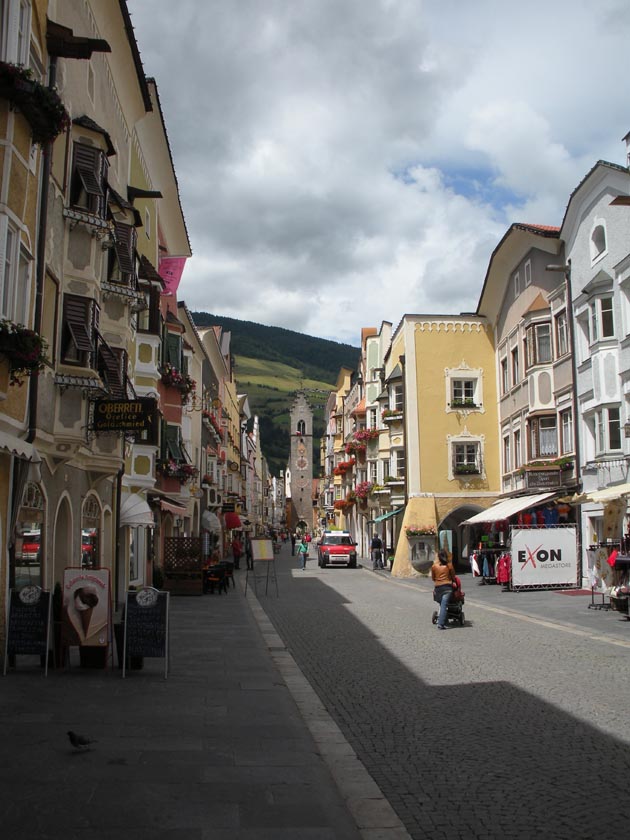 |
| Monday
-- 2:23 p.m. |
| This
is the town of Sterzing. Reinhard insisted on stopping here so he |
| could
purchase a special brand of schnapps, available only in this region |
| --
at a special price. While he wandered off in search of his prize,
I sat |
| at
the first outdoor cafe on the left and ate an apple strudel with coffee. |
| |
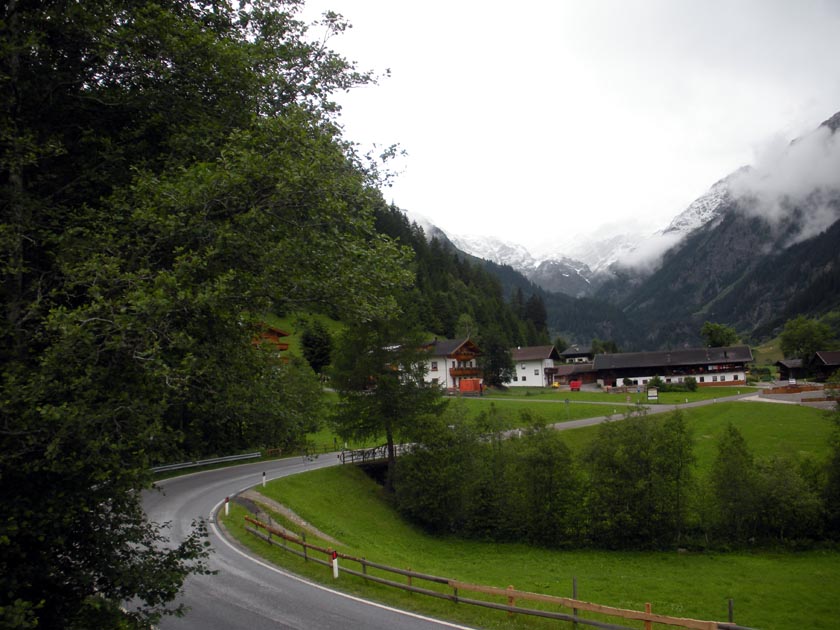 |
| Tuesday
-- 9:34 a.m. |
| This
is the tiny "dorf" of Ratchings where we spent Monday night --
in a small pension on |
| a
farm behind the second white building in the distance. The Hotel
Sonklarhof, located five |
| hundred
meters to the rear of this photo, where we had hoped to find rooms, was
booked out. |
| In
the end, that turned out to our advantage, because at the small pension
Residence Rainer, |
| we
were each given a fully furnished apartment for only 38 Euros the night,
breakfast included. |
| As
a bonus, the polite and smiling young lady who checked us in and served
our breakfast the |
| next
morning introduced herself as Miss Katja Haller, a member of the Italian
National Biathlon |
| Team.
She announced that it had rained all night. Note the fresh dusting
of snow in the hills. |
| |
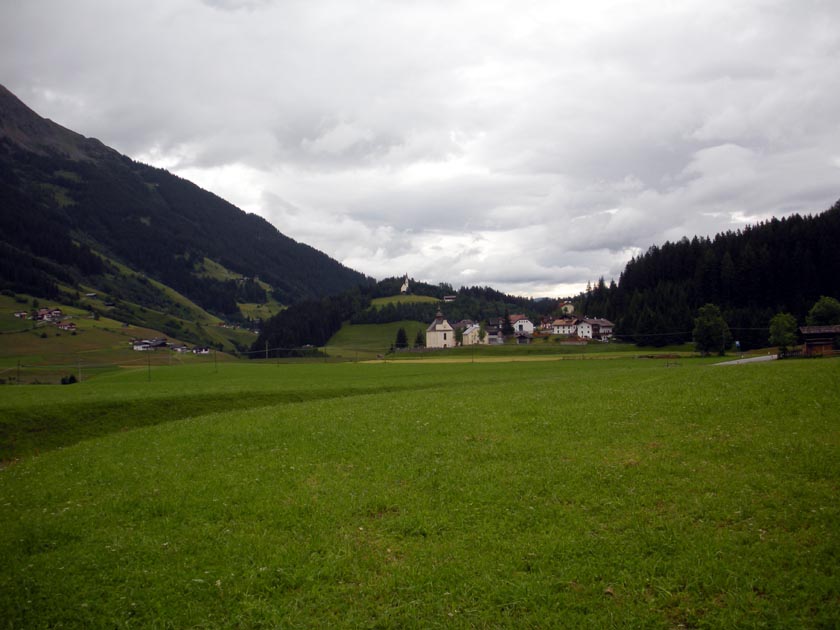 |
| Tuesday
-- 9:35 a.m. |
| This
is 180 degrees from the previous photo -- the final day and the road
home. |
| |


































